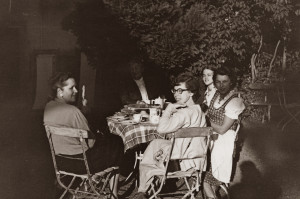 From left, clockwise around the table, Carmen, ?, Maria, Hilde, Joan. Photo by Fred Stotz. Summer 1949.
From left, clockwise around the table, Carmen, ?, Maria, Hilde, Joan. Photo by Fred Stotz. Summer 1949.
This blog is about the obvious–that when you write or talk about your culture, you inevitably discuss place, food, and basic necessities.
* * *
From 2005-2007 I took a detour from teaching at the College of Wooster to teach at the higher-ranked Grinnell College, which is located in a small town (Grinnell) of 8,000 residents in the middle of Iowa. It was an opportunity for me and a tough transition for Charles, although he ended up so comfortable and happy there with his friends Rafe, Nick, Josh and David that it was an even tougher transition for him to return to Wooster.
For six weeks, my first year, we were joined by Ulli, Hilde’s granddaughter, who wanted to improve her English. I had emailed Christa, her mother, and forewarned her, “Please tell Ulrike that Grinnell is a small, isolated town; it will be boring here.” Ulli wrote back, “I am used to a small town.” What Ulli discovered, when she arrived, was that she was used to a small town in northern Germany. Almost all small towns there are easily accessible to cities via streetcars, trains, and buses. Grinnell’s closest city was an hour away, and there was no public transportation between Grinnell and any city. I believe that Ulli discovered the meaning of “isolated” over those six weeks in a small town surrounded by miles (literally) of cornfields and only survived because she made friends with a firefighter’s wife.
https://en.wikipedia.org/wiki/Grinnell,_Iowa. (modified June 5, 2015). Web. June 24, 2015.
At Grinnell I discovered three things: 1) That Wooster, was not, as I had previously thought, in the Midwest. The real Midwest was in Grinnell, 620 miles to the west. 2) That I was too old to adjust to living in the middle of the United States where everything seemed to be flat, rudimentary, and far from water. 3) That fresh food is surprisingly hard to get in the breadbasket of America, as its mega-farms harvest up their bounty in huge batches and immediately ship it all over the world except leaving Grinnell bereft of fruit and vegetables. So, over the winter, I would order vegetables from California.
I discovered a variation on this last concern when I found myself on a search committee for Ethnic Studies/Creative Writing at Grinnell College. The submitted writing samples included realist and magical realist writing, straightforward and baroque styles, accessible and disorienting vocabularies, all from a variety of Asian, African American and Latino cultures. But after a while we noticed that most of the writing samples had one thing in common–food. This realization came to the fore when my colleague, Ralph, promoted one sample because, as he put it, “This is the only one that’s not about food.” Eventually, however, we ended up hiring someone who had written a short story that was centered around the Vietnamese cuisine of his childhood. He didn’t work out at Grinnell; but that’s another story.
* * *
Hilde: in those days we lived by the Martins Tower (Martinstor), over the shop, under the roof.
That sentence brought me back to my first visit to Freiburg-im-Breisgau in 1968, when I was twelve-years-old. Freiburg, and the Black Forest that surrounds it, immersed me in my childhood notion of what Germany would be like–so much so that it felt like a welcome home after our disorienting tour through what seemed to me to be dark Gothic, Madrid homes; damp, cold, dirty London (it was quite cold that summer–the first thing my mother did was buy me a coat); a lovely idyll in Amsterdam, with its canals and hot chocolate (perhaps the origin of my love for boat tours); and the beautiful medieval/Renaissance Lucerne, with its picturesque buildings, but terrifying seventeenth-century mural of the dance of death, which occupied my dreams for a while.
https://ashrarebooks.wordpress.com/2012/09/29/lucerne/. 9-29-2012. Web. 6-22-15.
What struck me about Freiburg was not only the lush enchanted-forest look of chalet-type houses in the Black Forest or the quaint, still much-inhabited, wooden houses with thatched roofs, but the way that houses had flowers painted on the outside. The word “charm” is not enough to elicit the feeling of delight and discovery on seeing what amounted to a Grimm’s fairy tale setting, but in the sunlight and without goblins, witches, or stepmothers.
 Hotel Bären, Freiburg. My photo. 8-19-11.
Hotel Bären, Freiburg. My photo. 8-19-11.
Onkel Fred’s clock shop was part of this delight. Whirring and ticking clocks neatly placed everywhere, with the enchanting cuckoo boinging out of clocks and a warm feeling of wood everywhere. Occasionally, a little circle of wooden figures would do a kind of dance around the top part of a clock. At eye-level there were cases with watches of all shapes, sizes, and colors in them. I remember being particularly fascinated by a watch whose face frame one could actually change. I was so taken with a red enamel face that I’m surprised I’ve never brought one like it. But I did know that it was too expensive to ask for, so it has lingered as a kind of consumerist dream at the edges of my consciousness.
Freiburg remains charming, colorful, and cobblestoney, but one is jostled about more, as the small city has blossomed into a major university town and tourist center. The Stotz clock store is now a Segafreddo espresso shop; I never went in–it was always so crowded, almost as crowded as the adjacent MacDonald’s.
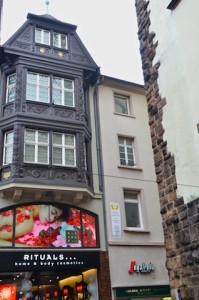 The Stotz shop and flat in the 1940’s; now a Segafreddo. My photo. 12-14-12.
The Stotz shop and flat in the 1940’s; now a Segafreddo. My photo. 12-14-12.
* * *
As Hilde chatted with me about 1949, we drank tea and nibbled on the kind of cookies she would send us during Christmas. So it’s not surprising that when we remembered Joan, we thought first of food.
Terry: And Joan–she wouldn’t eat potatoes, right?
Hilde (laughing loudly, strong emphasis on the “J” as a hard “Ch”): Joan!!!!
Terry: She always wanted….
Hilde: The diet–the diet! Diet! Diet! (die Schlank! Schlank! Schlank!)
(fairly extended pause to laugh, both of us clearly remembering how stick-like thin Joan was)
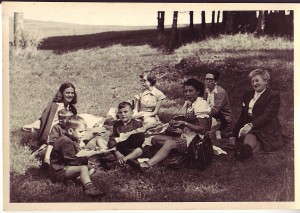 Proof that Joan occasionally ate. From left to right, Mami, Joan, Hilde, Carmen, and Onkel Fred’s sister. In the front–the three boys. Photo taken by Onkel Fred. Summer, 1949.
Proof that Joan occasionally ate. From left to right, Mami, Joan, Hilde, Carmen, and Onkel Fred’s sister. In the front–the three boys. Photo taken by Onkel Fred. Summer, 1949.
Here, too, Joan was the archetypal American tourist. Maria talks about how, on their first visit to the Stotzs’, Fred and Hilde, still struggling financially and dealing with postwar food shortages, nonetheless plied their guests with a cornucopian feast, piled high with sausages, local bread, and pastries. My mother said, “I can’t imagine how much this cost; and they had no money.” As Hilde offered her guests food, Joan responded,
“No thank you, I’m on a diet.”
I can only wonder how Fred and Hilde Stotz–having until recently lived through extreme food shortages–took this statement. It must have sounded like utter nonsense. I think Mami is still embarrassed by Joan’s response.
This is a good moment to remind our readers that Joan had American standards of hygiene as well, standards so inbred that she could not even imagine someone using a chamber pot for its original function, which is why she used one as a bowl in which to present fruit to friends.
So, perhaps, her response–at the under-the-roof flat near Martinstor while visiting with the Stotz family and being plied with food that she wouldn’t eat–was not surprising.
Hilde: And then Joan decided that she needed to use the bathroom–the bathroom was in the back, by the kitchen.
Being well-brought up, Joan didn’t come out and ask where the bathroom was, but discretely got up to hunt for it.
Hilde: And we just heard Joan cry out: “NAAAHYYY! In the water!” And in the bathroom–in the bathtub–she found three young children in the same water, full to the brim.
(long pause for hysterical laughter.)
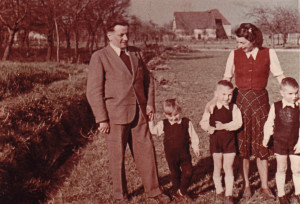 The three Stotz boys outside of the bathtub. Photo from Hilde Stotz. 1950?
The three Stotz boys outside of the bathtub. Photo from Hilde Stotz. 1950?
Terry (laughing, while trying to think and speak in German): “… it was–ah–ga–it was Peter, Michael, Mannfred?”
Joan’s response was not only surprise at finding the bathroom stuffed with boisterous boys, but also something like horror at witnessing three dirty young boys splashing about in the same bathwater. Scarcity of water was simply not a concept for her.
Hilde: “Ja. And your mother had then said: ‘She’s screaming?” And I said: ‘she had an unexpected event.’ Then your mother said: “She can be the godparent to the baptism!” [I believe she was playing with a pun on “Baden.”]
Terry: Un hunh. [Code for “I didn’t quite get that, but when I listen again and look up some words, I will.]
Alabama: a Coda
As a coda to this conversation, we ended up discussing my short-lived (two year) sojourn in Mobile, Alabama, where I lived from 1995-96. It struck me how much of my life Hilde not only knew about but remembered. She wondered if I was homesick for Alabama. “No,” was my emphatic response, as I added that my friends there had left and that the university had not been a great place, although the city itself was lovely. But I mentioned that I’d like to go back there to show Charles where he was born.
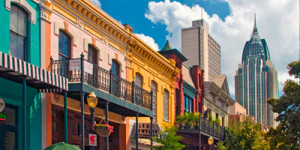 Downtown Mobile Alabama. sa.amateurtraveler.com/travel-to-alabama. n.d. Web. June 22, 2015.
Downtown Mobile Alabama. sa.amateurtraveler.com/travel-to-alabama. n.d. Web. June 22, 2015.
Only later did I remember that Hilde had wondered about Anisa being homesick. Might Hilde be homesick for her youth in Berlin, or is it that, having lived almost all her life in Freiburg-im-Breisgau, she found it hard to imagine moving away from home?
It was getting late enough that I thought it was time for me to go into Freiburg. Tante Hilde answered, with a laugh.
Hilde: well, you can always find me here. And if you can’t find the place, call out, and I’ll say… “Teeeeeryyyy” (loud), then you can walk towards my voice.
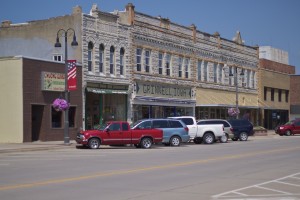
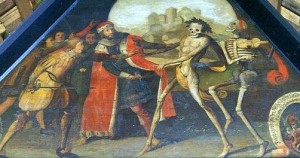
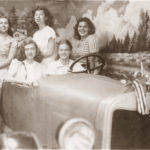
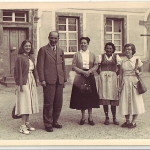

Speak Your Mind